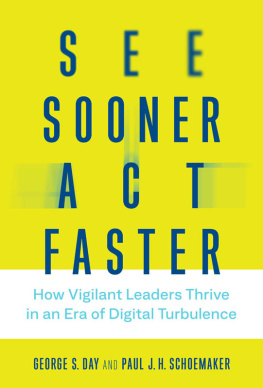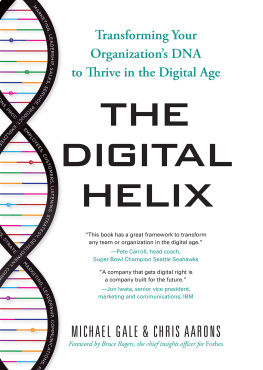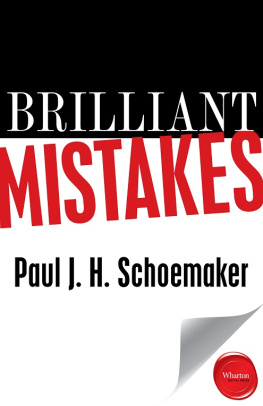Management on the Cutting Edge Series from MIT Sloan Management Review
Edited by Paul Michelman
Published in cooperation with MIT Sloan Management Review
The AI Advantage: How to Put the Artificial Intelligence Revolution to Work
Thomas H. Davenport
The Technology Fallacy: How People Are the Real Key to Digital Transformation
Gerald C. Kane, Anh Nguyen Phillips, Jonathan Copulsky, and Garth Andrus
Designed for Digital: How to Architect Your Business for Sustained Success
Jeanne W. Ross, Cynthia Beath, and Martin Mocker
See Sooner, Act Faster: How Vigilant Leaders Thrive in an Era of Digital Turbulence
George S. Day and Paul J. H. Schoemaker
See Sooner, Act Faster
How Vigilant Leaders Thrive in an Era of Digital Turbulence
George S. Day and Paul J. H. Schoemaker
The MIT Press
Cambridge, Massachusetts
London, England
2019 George S. Day and Paul J. H. Schoemaker
All rights reserved. No part of this book may be reproduced in any form by any electronic or mechanical means (including photocopying, recording, or information storage and retrieval) without permission in writing from the publisher.
This book was set in Stone Serif and Stone Sans by Westchester Publishing Services. Printed and bound in the United States of America.
Library of Congress Cataloging-in-Publication Data
Names: Day, George S., author. | Schoemaker, Paul J. H., author
Title: See sooner, act faster : how vigilant leaders thrive in an era of digital turbulence / George S. Day and Paul J. H. Schoemaker.
Description: Cambridge, MA : MIT Press, [2019] | Series: Management on the cutting edge | Includes bibliographical references and index.
Identifiers: LCCN 2019006921 | ISBN 9780262043311 (hardcover : alk. paper)
Subjects: LCSH: Leadership. | Management--Technological innovations. | Vigilance (Psychology)
Classification: LCC HD57.7 .D7347 2019 | DDC 658.4/092--dc23 LC record available at https://lccn.loc.gov/2019006921
Contents
List of Figures
Series Foreword
The world does not lack for management ideas. Thousands of researchers, practitioners, and other experts produce tens of thousands of articles, books, papers, posts, and podcasts each year. But only a scant few promise to truly move the needle on practice, and fewer still dare to reach into the future of what management will become. It is this rare breed of ideameaningful to practice, grounded in evidence, and built for the futurethat we seek to present in this series.
Paul Michelman
Editor in chief
MIT Sloan Management Review
Acknowledgments
A handy metaphor for conceiving and writing a book is taking an ancient caravan journey. It starts with a vision of the destination and enthusiasm about the possibilities. While underway, it requires persistence and patience to deal with the inevitable delays and detours. Most of all, the writing journey draws on the support of colleagues, friends, and family members to reach its destination.
We came together on this journey because of mutual respect and a history of successful collaboration. We maintained our compass heading with the help of an extended community of thought leaders, scholars, and business leaders. Our colleagues at the Wharton School and especially at the Mack Institute for Innovation Management were invaluable at many stages of the journey. We also benefited from fruitful personal interactions with professors Barb Mellers, Saikat Chaudhuri, Tom Donaldson, David Reibstein, Harbir Singh, J. Edward Russo, Greg Shea, David Teece, Michael Useem, Phil Tetlock, and Jerry Wind.
During our journey of discovery and learning, we benefited from clients such as Abbott Labs, Novartis, Cancer Treatment Centers of America, Ferrero, Knight Foundation, European Central Bank, Medtronic, the Prime Ministers Office of the United Arab Emirates, UBS, and W. L. Gore and Associates. These and many others allowed us to apply our ideas and methods to their adaptation challenges, yielding invaluable feedback. Especially useful guidance came from participants in executive education programs where our ideas often were first discussed. We have also both benefited from our experiences in starting companies and serving on diverse boards of directors. These real-world settings deepened our appreciation of the key roles that leadership teams play in guiding and completing any journey.
Many books are started, but few successfully reach their final destination. Karen Christensen and Kirsten Sandberg served as our editorial harbor pilots, taking the readers perspective to challenge us to develop persuasive and engaging narratives. We are grateful to all those who gave us constructive feedback along the way, including Charles Baden-Fuller of the University of London, Kaihan Krippendorff (founder of Outthinker Roundtable), Doug Randall (founder of Monitor 360), Govi Rao (former CEO of Noveda Technologies), Paul S. Schoemaker (President of Public Salt), Michael Taylor (CEO of SchellingPoint), Alan Todd (CEO of CorpU), and Toomas Truumees (partner at Heidrick and Struggles). They gave freely of their time to discuss nuances in the chapters while pressing us to further clarify our concepts and explain the reasons behind our recommendations. Along the journey, Erika Burnett at Wharton kept the manuscript moving forward with skill and unfailing good cheer.
Just as maps and satellite navigation systems are essential to travelers, so were the in-depth surveys we collected from 335 vigilant and vulnerable organizations to validate our model. Senior participants in many executive programs, leadership meetings, and conferences were a great help as well. Special thanks go to the organizations that saw the possibilities of our journey and gave us high-level access to their members. Mette Laursen of LinKS in Denmark, Sam Gill of the Knight Foundation, Vanita Bhargava of the Council on Foundations, and George Hofheimer of the Filene Research Institute, all went above and beyond to adapt our survey and the findings to their own distinct environments.
A writing journey needs sponsorship, encouragement, and hard-nosed feedback from a publisher. The editors at the MIT Press were early to see the potential of our book project, especially why digital turbulence increasingly poses new challenges for leaders and organizations. We benefited from the broad vision of Paul Michelman (editor in chief of MIT Sloan Management Review) and the sure-handed editorial oversight of Emily Taber (acquisition editor at the MIT Press). They and their staffs were a pleasure to work with and very helpful along the way.
Above all, we are grateful for the understanding and unconditional support of our dear wives, Alice and Joyce, who sustained us at every step of the writing journey. We dedicate this book to them.
George S. Day
(Villanova, Pennsylvania)
Paul J. H. Schoemaker
(Delray Beach, Florida)
Introduction
Turbulence, by definition, is irregular, non-linear, erratic. But its underlying causes can be analyzed, predicted, managed.
Peter F. Drucker
We live in an increasingly turbulent world, filled with both leadership dilemmas and unlimited opportunities. This relentless turbulence can be managed, just as whitewater rapids are navigable with a vigilant guide. But it demands different capabilities from those used to manage the current operations. This book is for leadership teams that need their organizations to become more vigilant and able to navigate the increasing turbulence magnified by the inexorable process of moving from analog to digital.
Vigilant firms have greater foresight than their rivals. Charles Schwab was early to see and act on the promise of robo-advisors, GM jumped ahead of Ford in the world of autonomous cars, and Novartis led others in equipping their sales teams with a digital platform to access medical expertise for doctors in real time. Such vigilant firms win at the expense of their slower rivals. Vulnerable firms, on the other hand, often misread early signals of external threats or internal organizational challenges. Honeywell stumbled when Nest Labs came out first with a sleek, Internet-enabled thermostat, an early tool in the creation of the nascent smart home. Volkswagen crippled itself with revelations that it created intelligent systems inside its cars to fake emissions test results. Dansk Bank, Denmarks largest lender, spiraled down from being one of Europes most respected banks after being caught in a massive, 200-billion-euro money-laundering scandal in which it ignored many red flags.
Next page






